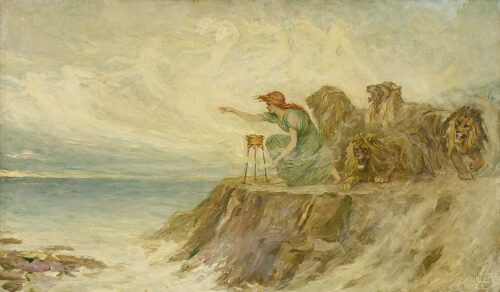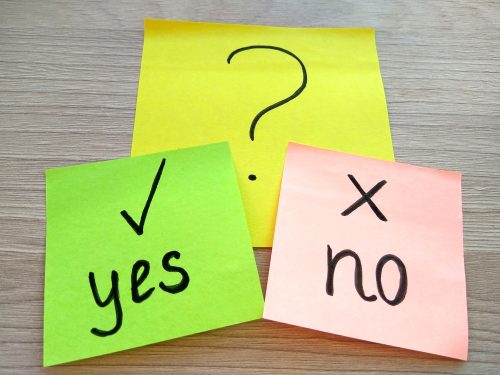Intuitive versus knowledge-based tarot reading seems to be a popular topic for discussion lately. Whenever it comes up, people are quick to jump into a camp and defend their position. Last night, because it is a potential Denver Tarot Meetup presentation topic for 2012, I brought it up with DTM Founder Scott Womack and my assistant organizer John Allen. It didn’t take very much discussion before Scott pointed out that there are a lot of assumptions that happen when people hear these terms, and those stereotypes are what really need to be addressed. I couldn’t agree more.
To be honest, I get a little prickly when people bring up the subject because they tend to quickly assign me to a camp and then the typecasting begins. Usually I get assigned to the knowledge-based camp, although on occasion I’m surprised to discover that someone has sided me with the intuitives. It doesn’t matter though, in that I don’t consider myself to belong to either camp. And truth be told, I think very few readers belong strictly to one or the other of these tarot taxonomies. What I find funny, when I’m not caught up in the prickles, is that even though most people consider me to be a knowledge-based reader, my students consistently describe my methods in class as intuitive.
Generally, knowledge-based readers are considered readers who value research into tarot history, commonly accepted meanings assigned to the cards, and memorizable facts and correspondences for the cards. Intuitive readers are painted as using the cards as a scrying tool, from which they connect to their empathic, intuitive or psychic gifts, or from which they open a dialogue with spirit guides, angels, or those who have passed to the other side of the veil. Almost all the tarot teachers I know value the fact that tarotists can and will pull from both knowledge and intuitive insight while reading.
One colleague of mine, an intuitive reader, is proud to say that she doesn’t know the meanings of the cards. I always smile and nod when she says this, but one time she said it so many times that I finally responded that I never learned meanings for the cards either (and I hold firm to my belief that the cards are meaningless without being placed in the context of a question). I asked her how she taught intuitive tarot, and it turned out that she gave her students lists of what numbers mean, what colors mean, and what the tarot suits mean. I have to admit to a secret smile when I observed a group she taught. After reviewing the intuitive process, she set them loose with a large stack of handouts. All these intuitive tarotists proceeded to simply read from various pages as they flipped back and forth to match color, number and suit to card.
I was participating in that class as well, and chose a deck that I had never seen before and which didn’t strictly follow any particular deck design lineage. I read the cards based more on my own teaching methods (no handouts needed), and further complicated the issue by selecting a black and white deck. One of the instructor’s regular students observed me reading these cards and I said to him, what do you think this means? His response was to remind me that he had studied under two different intuitive teachers, and so he didn’t know the meanings of the cards and was unable to tell me what this spread meant.
I definitely don’t blame his teachers—I know, like and respect both of them—but this is a typical response when someone places themselves under the limiting belief that there is a distinction between knowledge-based and intuitive reading. He assumed that I knew some “right” answer out there and that he shouldn’t even bother trying to guess because intuition can’t lead one to quantifiable fact. I think herein lies one of the main problems that arises from intuitives who lock the doors and pull down the shades when confronted with someone who has built up a knowledge base around the cards. “Intuition” comes from the Latin “to know within” and is indeed as much about accuracy and truth as knowledge based reading.
In fact, I like to distinguish between “intuitive” and “instinctive” readers. I think a lot of inexperienced readers who take an intuitive approach without training end up responding instinctively to the cards rather than finding and connecting to their inner knowledge. Instinctive interpretations usually result in these readers projecting their personal biases, fears, ideals and values on the cards and ultimately on their clients. The very first thing I teach in class is for my students to bring awareness to what triggers their personal stuff so that they can move past instinctive reactions and begin to look deeper within themselves to a level of compassion that touches the throne of intuition.
Another important tool I teach is systems of correspondence. In fact, that’s what the intuitive instructor was doing with her stacks of handouts, she simply didn’t realize that she was sharing a base of knowledge with her students, because she considered knowledge to mean that one assigned a distinct definition to each card. So basically she and I teach the same way, and since neither of us ever learned the meanings of the cards, there really is no difference between her style and mine– well, other than the fact that she talks directly to dead people. I simply quote the published writings of dead people. Intuitive versus knowledge based in a nutshell!
In my marketing materials, I say that systems of correspondence are the structure that underlies intuition. Systems of correspondence are ways of categorizing and filing information. For example, the relationship between the tarot suits and the elements is a system of correspondence. This is a great place to start because we immediately come up against the boundaries of the system and students can quickly see both the freedom and limitations to how this works. I teach the esoteric correspondence for the suits and elements. In this tradition, the four suits follow the four seasons, as assigned according to the cardinal signs of the zodiac. The wands with their budding leaves are assigned to the spring, Aries, cardinal fire, the sign of the initiator and pioneer. Cups are accorded the symbolism of the nurturing and emotionally compassionate Cancer, cardinal water, the sign that marks the beginning of summer. Swords relate to the sign that marks the beginning of autumn, Libra, cardinal air, the balanced scales of justice and the resulting fair and decisive judgments. And Pentacles or coins are matched to winter, which starts on the cusp of Capricorn, cardinal earth, associated with career, success, authority, and the patient accumulation of wealth.
The beautiful thing about systems of correspondence is that there is no right answer—only common ways of making the associations. Another common correspondence for the tarot suits and elements is the Neo-Pagan directional associations for the elements. (I commonly refer to this as the Wands/Swords elemental swap.) This system draws from the four seasons and the four times of day, similarly to the esoteric associations, but based on psychological symbolism rather than astrological meaning. Spring or dawn is in the east, summer or noon in the south, fall or dusk in the west, and winter or midnight in the north. In this system, again, not a definitive system but a commonly used one, the light, airy, breezy quality of spring is assigned to air and the budding branch of the wands with their scent of spring blossoms. The hot, dry summer is assigned to fire and the sword which is forged in fire but not destroyed by fire and used as the weapon of choice by the fiery Mars-ruled warrior. The cool, dim evening in which lovers come together to watch the setting sun is assigned to water and the tarot suit cups, the symbol of love and relationships. And the cold, dark, barren winter, the time of relying on one’s stockpile of provisions, corresponds to the metallic sterility of pentacles, the coins that one collects and stores in pocket, purse or safe deposit box. A quick review of different decks will reveal even more ways of making the correspondences. [See my post on the four seasons and the four tarot suits.)
Once set loose with this way of approaching symbolism, creative students can make up their own systems of correspondence in order to bring in a knowledge base they already have studied, but which hasn’t previously been assigned to the tarot. Alternately, students trained in this methodology are much more likely to look for patterns in the images of the cards so that they can discover the system of correspondence used by the deck creator, and in so doing honor the author’s intention rather than trying to plaster previously memorized meanings over top of whatever deck is placed in front of them.
To me, the system of correspondence—or simply, the knowledge base—is like an artist’s armature. The armature is the framework that supports the sculpture that an artist is creating. It’s a wire stick figure that can be bent into any shape to give direction and form to the artist’s work. Intuition is like the artist’s process—the unique and indefinable way the artist works to manifest their artistic vision into concrete form. The resulting interpretation that the reader provides for the querent is the finished sculpture, which may or may not please the one who commissioned it! Intuition without underlying form is liable to waver and collapse without the direction and support of the appropriate system of correspondence. Knowledge alone is so bare bones that it produces an uninspired and typically impersonal interpretation. Truly artistic tarot readings are the result of the interplay of a structure of knowledge draped with the diaphanous beauty of intuition. Almost all readers use both, but most readers are stronger in one area than the other.
A good reader will work to develop both sides equally and will not limit their abilities by denying themselves either their armature or their art.
Joy Vernon is a Certified Professional Tarot Reader and Reiki Teacher in Denver, Colorado. Her specialty is the Empyrean Key Transformational Guidance, which combines energetic and esoteric modalities to help her clients break through blocks and align themselves with their higher purpose. To schedule an appointment, please visit JoyVernon.com.
© 2011 by Joy Vernon. All rights reserved.







